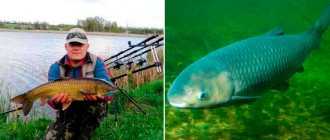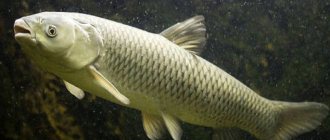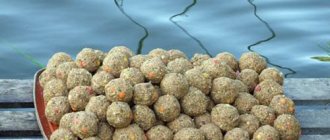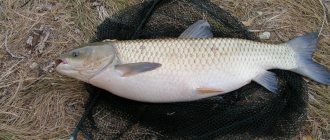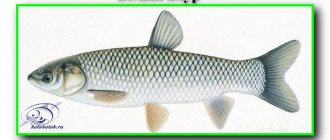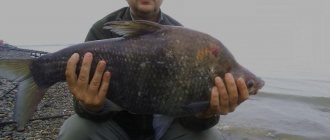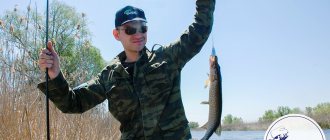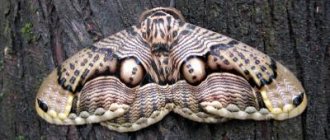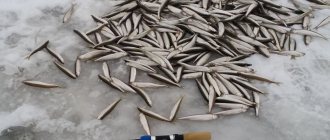Equipment for reed fishing
The gear for catching grass carp must be for large specimens, durable and reliable, because the fish in question resists strongly. The main line should be chosen hard, with a diameter of at least 0.5 mm, the liner can be soft, of the same thickness. The hooks are powerful, with a medium shank; the size depends on the weight of the fish that lives in a particular body of water, for example, from No. 5 and above. The sinker should be sliding, weighing about 100–150 g. The reel should be reliable and can withstand heavy loads well.
Did you know? White amur
—
quite a voracious fish: it can eat as much as it weighs. For this she was even nicknamed “little pig.”
Bottom tackle for white carp
To catch grass carp, I recommend using a good carp rod, which can relatively easily cope with a 5-kilogram carp on a hook, and such carp is far from uncommon when catching carp on a donk. If you catch a cupid along the way when catching other fish on a float or donk, then most often you come across small cupids of half a kilo, but if you are going to catch it purposefully, use the right bait and bait, then you should always be prepared for a bite from a large cupid.
I dare to assure you, despite the fact that everyone says and writes that to catch grass carp you need only expensive and good gear, you can catch carp with a cheap Chinese spinning rod, and the carp is of a good size. I myself caught heavy grass carp using cheap tackle and the result was successful, but there are still some disadvantages.
The main disadvantage is that with a carp rod I could easily send the bait 5 times further than with the maximum cast with cheap gear. Because of this, there were much fewer bites on the Chinese spinning rod and such large specimens as on the carp rod were not caught. In addition, the reservoir on which I fished was quite narrow, about 100 meters wide, and with a carp rod I placed the bait clearly under the reeds on the opposite bank, which was not accessible and could only be reached from this bank. Because of this, the cupid felt very good there - a lot of food and no danger. But with cheap tackle I couldn’t even reach the middle of the pond, and this resulted in fewer bites.
The next disadvantage is, of course, the process of landing fish. Fishing for a three-kilogram carp with cheap tackle turns into a real struggle for survival. The rod doesn't do a good job of holding the fish; it looks like there's a whale on the hook. While even a 6-8 kg carp comes out much easier on a carp rod. Although when fishing with cheap tackle, you can get much more emotions and adrenaline in the fight against cupid.
Any large fish is caught much less often on a donkey with a feeder than on a hair rig, and cupid is no exception. When catching grass carp on a donk, it is optimal to feed the fishing area in advance or after casting the rods, but do not use feeders in the equipment in order to less alarm the fish.
But if, when catching carp on a donk with a feeder, you mount a long leash of about 50 cm from the feeder to the hook from a fishing line of at least 0.2 mm, then the carp will bite more confidently and the likelihood of biting a large carp will increase significantly. Use a rig with one hook, otherwise the rig will get tangled all the time, and the second hook can get in the way when fishing for carp by getting caught on a reed or an underwater obstacle.
Even one hook can get tangled when casting, which will lead to an empty wait for the carp to bite. To prevent the leash from getting tangled, it is better to attach the hook with bait to the feeder when casting. When it falls into the water or after the bait begins to dissolve in the water, the hook will lie next to the feeder.
Bottom tackle equipment for carp:
- rod - 3.6 meters (optimal);
- coil - 3000-3500;
- a fishing line with a minimum diameter of 0.25-0.3 mm, if the probability of a cupid bite is over 4-5 kg, the fishing line is up to 0.6 mm.
- the cord can be thinner than the fishing line, but with approximately the same breaking load;
- You can use a carp hook No. 5-8.5 according to the domestic classification (No. 10-3 according to the international classification).
Feeding grass carp
One of the main factors of effective fishing is considered to be feeding, because it significantly increases the quantity and probability of catch. As you know, grass carp eats a lot, so you will need quite a lot of bait. You can buy it or prepare it yourself - in this case it will be much cheaper and no less effective than store-bought counterparts. Porridges made from pearl barley, peas, millet, wheat, various bran are also used as complementary foods; canned corn, makha (sunflower seed cake), crackers, watermelon rinds, boiled potatoes, cucumber ovaries, milky corn stalks, bunches of young pea leaves, are also suitable. vetch, clover, aloe leaves, filamentous algae.
Experienced fishermen add sweet ingredients to complementary foods - condensed milk, honey, cookies, milk powder, various attractants and fruit flavors.
Tips for catching carp in spring
Despite the similarity in habits and choice of baits, cupids nevertheless differ from carp and crucian carp in that they often take the bait not from the bottom, but near the bottom and even in half-water . This is due to the fact that cupids nibble edible growths and all kinds of water bugs from the stems of reeds and other plants. Therefore, floating baits and boilies will be more effective in catching carp.
In late spring , when vegetation is already appearing, but not yet in large quantities, carp are successfully caught right in the reeds. And often the best bait here is the young reeds, which are still tender and juicy.
To ensure that the nozzle is higher than the bottom , foam balls are often used, mounted on a hook or attached to a special hair. In addition, such balls can also serve as a bait if they are rolled in some effective and aromatic dip. Such dips are specially produced for foam nozzles so that they can be covered with a food layer. There are liquid and dry dips. These dips have the ability to hold the scent until the day's fishing is over. Therefore, artificial baits are sometimes more effective than natural ones.
Methods of planting reeds
Since the described type of fish feeds on plant foods (algae, young shoots, leaves, etc.), reeds are suitable for fishing, especially in spring. There are several ways to plant this plant, which will be discussed below.
Leaves
One of the unusual baits that is used for fishing in almost any body of water is reed leaves.
We also recommend reading how to catch carp with boilies.
To do this you need:
- Pluck the top succulent leaves of the young reed, tear the leaf into small pieces measuring 1x2 cm. About 10 strips are enough for one hook.
- Make small cuts on each piece so that the plant releases juice, thereby luring fish.
- Then place them on a fishing hook.
Stem
For this method you need:
- Cut the reed at the base, remove the top, clear the stem of leaves and shell. It is better to leave the top layer so that the flesh does not fall apart and is easy to put on.
- Then break off a piece of the required length, depending on the size of the hook. It should be slightly smaller than the shank of the hook and not cover the eye.
- Next, put on the stem, now you can remove the top shell. The insertion is carried out so that the tip remains open.
With the stem rigging method, it is best to tie the line to the hook last.
On the hair
The hair fishing method is suitable for fish weighing more than 3 kg.
We recommend learning how to make a homemade underwater camera for winter fishing.
It is done like this:
- Select young fresh reeds, tear off a leaf, divide in half lengthwise, divide each part into segments 2.5 cm long, stack them on top of each other in a stack about 3 cm high. You can make cuts, punctures, or rub a little on pieces of leaves to let out the juice.
- Place a piece of polystyrene foam measuring 1.5 x 1.5 cm onto the awl, then pierce the reed blank with it.
- Hook the hook of the sewing hook into the loop at the end of the hair and carefully move the entire stack onto it, securing it with a stopper.
How to prepare reeds
Reed bait is very effective and interesting. Just for it to bring you success in fishing, you need to know some rules.
Read more:
Fishing for pike from the shore
So, we need reeds about a meter high. More precisely, cut down to this level. Not just any shoot will do, but one that has a few fresh leaves at the end. Usually the cupid swims in the upper layers of the water, and if it sees that the reed has sunk into the water, or hangs low enough over its surface, the fish sharply pulls it down, biting off a decent-sized piece. So, now all that remains is to figure out how to prepare reeds for catching carp? Or more precisely, how to properly present the bait to the fish.
Where to begin? The first step is to hide the hook in the leaves so that it is not visible at all. Otherwise, Cupid will spit it out and all our efforts will be meaningless. Then a fishing line is wound around the reed stem in several turns. After this, it is important to make a tactically correct cast. What does it mean? It's simple. Your reed should fall into the water where it could theoretically do so on its own, and not in a random place on the pond. If the shoot stays afloat, it will interest the fish faster. And one more thing - do not use floats. Float tackle, like other foreign objects, can frighten off the cautious cupid.
How to catch grass carp using reeds
First of all, you need to choose a convenient place, feed it thoroughly and do this throughout the entire fishing period so that the fish does not swim away in search of food. If fishing takes place on a river, then you should choose a quiet, deep place where the water warms up well, there is a lot of plant food, as well as littered and flooded trees and snags. Next you need to attach the bait to the fishing tackle. The best fishing time is early morning and evening twilight.
Did you know? In winter, the body of grass carp becomes covered with mucus, which comes off and stretches into thin threads.
-
using them you can determine the wintering place of the fish.
Since grass carp is very careful, you should not make too much noise so as not to scare it away. Another important factor is that when fishing for fish, you should not loosen the line. You also need to have a capacious landing net.
To catch a decent trophy using reeds, you must adhere to all the rules for preparing for fishing for grass carp, described in this material.
Fishing tactics
So, the ice has broken, gentlemen of the jury. That is, we threw our bait and all we can do is wait. But some of you noticed that almost nothing was mentioned here about gear. Although they are no less important than the correct presentation of the “main course”. Let's start with the main point - the size of the fish. If you don’t know, cupid can weigh up to thirty kilograms. And its size is also impressive.
An adult grass carp can grow up to a meter, and sometimes more. Therefore, you need to choose a fishing rod that is as powerful and durable as possible. But it shouldn’t be too heavy either, otherwise you’ll be so tired after half an hour of fishing that you won’t even have time to wait for a bite. Let's return to our process. Not everyone knows how to catch cupids using reeds. But there is nothing fundamentally complicated here. Look for thickets. A place where the reeds stand like a wall. Cupids usually gather there to feed. And then it’s a matter of technology. We need to feed the place. A mixture of corn and reed core can be used as bait.
Read more:
Fishing for pike perch on the river
The cast is carried out beyond this zone, and then the tackle is simply smoothly pulled up using a reel. Large cupid always keeps to itself, not joining the flock. He walks along the very edge. So, if your goal is a larger fish, cast just beyond the edge of the place where the bait was scattered.
Note to the fisherman! Place the nozzle on the surface of the water. Cupid will pick up reeds from it with great success. He will pull the shoot into his mouth and pull it down. You can also use a float rod for this purpose. The equipment can be either blind or sliding. Cupid is good for catching in bad weather and at night. Night is generally a favorable time. The main thing is not to create unnecessary noise.
How cupid bites
Considering the very large size of the fish (length up to 1.2 meters, weight up to 32 kilograms!), you need to choose a stronger fishing rod for it. This can be a donka for silver carp, a feeder or boilie blind tackle. The bite happens instantly; If you don’t just as quickly take the fish to the shore, it will have time to turn around and hide in the reeds or somewhere under a snag, from where it most likely cannot be retrieved.
Do you know for sure that grass carp live in this place? Feed him properly, preferably corn. Throw half of the mixture into the middle of the point suggested to you, scatter the rest within a radius of up to five meters.
It is also recommended to catch carp on corn or the stems of this plant in the stage of milky ripeness. Also suitable are a cucumber ovary with an inflorescence attached to a hook, aloe leaves (don’t forget to cut off the thorns), and balls of cucumber-smelling mulberry algae that grows along the banks of reservoirs. Reed bait is also good.
